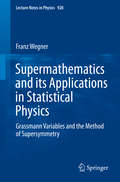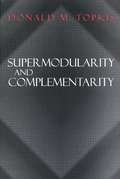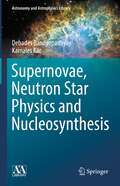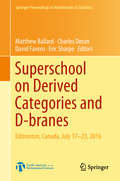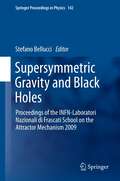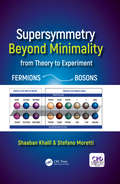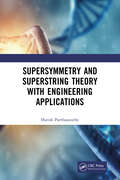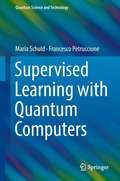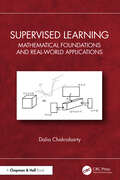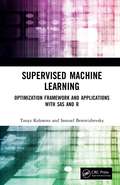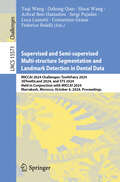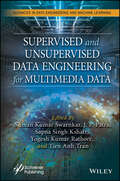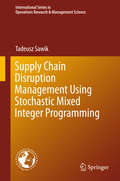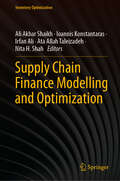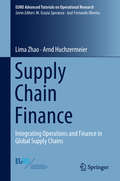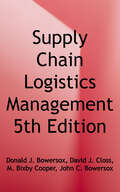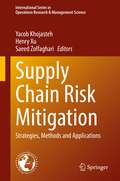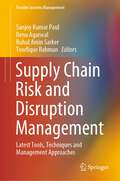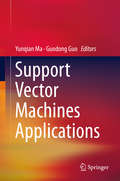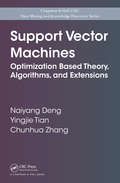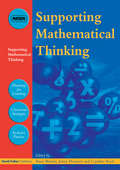- Table View
- List View
Supermathematics and its Applications in Statistical Physics
by Franz WegnerThis text presents the mathematical concepts of Grassmannvariables and the method of supersymmetry to a broad audience of physicistsinterested in applying these tools to disordered and critical systems, as wellas related topics in statistical physics. Based on many courses and seminarsheld by the author, one of the pioneers in this field, the reader is given asystematic and tutorial introduction to the subject matter. The algebra and analysis of Grassmann variables ispresented in part I. The mathematics of these variables is applied to a randommatrix model, path integrals for fermions, dimer models and the Ising model intwo dimensions. Supermathematics - the use of commuting and anticommutingvariables on an equal footing - is the subject of part II. The properties ofsupervectors and supermatrices, which contain both commuting and Grassmanncomponents, are treated in great detail, including the derivation of integraltheorems. In part III, supersymmetric physical models are considered. Whilesupersymmetry was first introduced in elementary particle physics as exactsymmetry between bosons and fermions, the formal introduction of anticommutingspacetime components, can be extended to problems of statistical physics, and,since it connects states with equal energies, has also found its way intoquantum mechanics. Several models are considered in the applications, afterwhich the representation of the random matrix model by the nonlinearsigma-model, the determination of the density of states and the levelcorrelation are derived. Eventually, the mobility edge behavior is discussedand a short account of the ten symmetry classes of disorder, two-dimensionaldisordered models, and superbosonization is given.
Supermodularity and Complementarity
by Donald M. TopkisThe economics literature is replete with examples of monotone comparative statics; that is, scenarios where optimal decisions or equilibria in a parameterized collection of models vary monotonically with the parameter. Most of these examples are manifestations of complementarity, with a common explicit or implicit theoretical basis in properties of a super-modular function on a lattice. Supermodular functions yield a characterization for complementarity and extend the notion of complementarity to a general setting that is a natural mathematical context for studying complementarity and monotone comparative statics. Concepts and results related to supermodularity and monotone comparative statics constitute a new and important formal step in the long line of economics literature on complementarity.This monograph links complementarity to powerful concepts and results involving supermodular functions on lattices and focuses on analyses and issues related to monotone comparative statics. Don Topkis, who is known for his seminal contributions to this area, here presents a self-contained and up-to-date view of this field, including many new results, to scholars interested in economic theory and its applications as well as to those in related disciplines. The emphasis is on methodology. The book systematically develops a comprehensive, integrated theory pertaining to supermodularity, complementarity, and monotone comparative statics. It then applies that theory in the analysis of many diverse economic models formulated as decision problems, noncooperative games, and cooperative games.
Supernovae, Neutron Star Physics and Nucleosynthesis (Astronomy and Astrophysics Library)
by Debades Bandyopadhyay Kamales KarThis book deals with the interdisciplinary areas of nuclear physics, supernovae and neutron star physics. It addresses the physics and astrophysics of the spectacular supernova explosions, starting with the collapse of massive stars and ending with the birth of neutron stars or black holes. Recent progress in the understanding of core collapse supernova (CCSN) and observational aspects of future detections of neutrinos from CCSN explosions are discussed. The other main focus in this text is the novel phases of dense nuclear matter, its compositions and equation of state (EoS) from low to very high baryon density relevant to supernovae and neutron stars. The multi-messenger astrophysics of binary neutron star merger GW170817 and its relation to EoS through tidal deformability are also presented in detail. The synthesis of elements heavier than iron in the supernova and neutron star environment by the rapid (r)-process are treated here with special emphasis on the nucleosynthesis in the ejected material from GW170817. This monograph is written for graduate students and researchers in the field of nuclear astrophysics.
Superschool on Derived Categories and D-branes: Edmonton, Canada, July 17-23, 2016 (Springer Proceedings in Mathematics & Statistics #240)
by Matthew Ballard Charles Doran David Favero Eric SharpeThis book consists of a series of introductory lectures on mirror symmetry and its surrounding topics. These lectures were provided by participants in the PIMS Superschool for Derived Categories and D-branes in July 2016. Together, they form a comprehensive introduction to the field that integrates perspectives from mathematicians and physicists alike. These proceedings provide a pleasant and broad introduction into modern research topics surrounding string theory and mirror symmetry that is approachable to readers new to the subjects. These topics include constructions of various mirror pairs, approaches to mirror symmetry, connections to homological algebra, and physical motivations. Of particular interest is the connection between GLSMs, D-branes, birational geometry, and derived categories, which is explained both from a physical and mathematical perspective. The introductory lectures provided herein highlight many features of this emerging field and give concrete connections between the physics and the math.Mathematical readers will come away with a broader perspective on this field and a bit of physical intuition, while physicists will gain an introductory overview of the developing mathematical realization of physical predictions.
Supersymmetric Field Theories
by Sergio CecottiAdopting an elegant geometrical approach, this advanced pedagogical text describes deep and intuitive methods for understanding the subtle logic of supersymmetry while avoiding lengthy computations. The book describes how complex results and formulae obtained using other approaches can be significantly simplified when translated to a geometric setting. Introductory chapters describe geometric structures in field theory in the general case, while detailed later chapters address specific structures such as parallel tensor fields, G-structures, and isometry groups. The relationship between structures in supergravity and periodic maps of algebraic manifolds, Kodaira-Spencer theory, modularity, and the arithmetic properties of supergravity are also addressed. Relevant geometric concepts are introduced and described in detail, providing a self-contained toolkit of useful techniques, formulae and constructions. Covering all the material necessary for the application of supersymmetric field theories to fundamental physical questions, this is an outstanding resource for graduate students and researchers in theoretical physics.
Supersymmetric Gravity and Black Holes
by Stefano BellucciThis book is based upon lectures presented in the summer of 2009 at the INFN-Laboratori Nazionali di Frascati School on Attractor Mechanism, directed by Stefano Bellucci. The symposium included such prestigious lecturers as S. Ferrara, G. Dall'Agata, J.F. Morales, J. Simón and M. Trigiante. All lectures were given at a pedagogical, introductory level, which is reflected in the specific "flavor" of this volume. The book also benefits from extensive discussions about, and the related reworking of, the various contributions. It is the fifth volume in a series of books on the general topics of supersymmetry, supergravity, black holes and the attractor mechanism.
Supersymmetry Beyond Minimality: From Theory to Experiment
by Shaaban Khalil Stefano MorettiSupersymmetry (SUSY) is one of the most important ideas ever conceived in particle physics. It is a symmetry that relates known elementary particles of a certain spin to as yet undiscovered particles that differ by half a unit of that spin (known as Superparticles). Supersymmetric models now stand as the most promising candidates for a unified theory beyond the Standard Model (SM). SUSY is an elegant and simple theory, but its existence lacks direct proof. Instead of dismissing supersymmetry altogether, Supersymmetry Beyond Minimality: from Theory to Experiment suggests that SUSY may exist in more complex and subtle manifestation than the minimal model. The book explores in detail non-minimal SUSY models, in a bottom-up approach that interconnects experimental phenomena in the fermionic and bosonic sectors. The book considers with equal emphasis the Higgs and Superparticle sectors, and explains both collider and non-collider experiments. Uniquely, the book explores charge/parity and lepton flavour violation. Supersymmetry Beyond Minimality: from Theory to Experiment provides an introduction to well-motivated examples of such non-minimal SUSY models, including the ingredients for generating neutrino masses and/or relaxing the tension with the heavily constraining Large Hadron Collider (LHC) data. Examples of these scenarios are explored in depth, in particular the discussions on Next-to-Minimal Supersymmetric SM (NMSSM) and B-L Supersymmetric SM (BLSSM).
Supersymmetry and String Theory, Second Edition: Beyond the Standard Model
by Michael DineThe past decade has witnessed dramatic developments in the fields of experimental and theoretical particle physics and cosmology. <P><P>This fully updated second edition is a comprehensive introduction to these recent developments and brings this self-contained textbook right up to date. Brand new material for this edition includes the groundbreaking Higgs discovery, results of the WMAP and Planck experiments. Extensive discussion of theories of dynamical electroweak symmetry breaking and a new chapter on the landscape, as well as a completely rewritten coda on future directions gives readers a modern perspective on this developing field. A focus on three principle areas: supersymmetry, string theory, and astrophysics and cosmology provide the structure for this book which will be of great interest to graduates and researchers in the fields of particle theory, string theory, astrophysics and cosmology.
Supersymmetry and Superstring Theory with Engineering Applications
by Harish ParthasarathyThis book introduces the vast subject of supersymmetry along with many specific examples of engineering applications, for example: • The design of quantum unitary gates using supersymmetric actions.• Bosonic and Fermionic noise in quantum systems using the Hudson-Parthasarathy quantum stochastic calculus.• Superstring theory applied to the quantum mechanics of neurons and supersymmetric quantum filtering theory which can, for example, be used to filter out the noise in a cavity resonator electromagnetic field produced by the presence electrons and positrons in a bath surrounding it.• Simplified versions of super-Yang-Mills theory with gauge and gaugino fields, both transforming under the adjoint representation of the gauge group and elementary super-gravity models have also been introduced. All through the book, emphasis is laid upon exploiting the supersymmetry existing in the nature of Boson-Fermion exchange in designing engineering systems like quantum computers and analyzing the performance of systems in the presence of supersymmetric quantum noise.
Supervised Learning with Quantum Computers (Quantum Science and Technology)
by Maria Schuld Francesco PetruccioneQuantum machine learning investigates how quantum computers can be used for data-driven prediction and decision making. The books summarises and conceptualises ideas of this relatively young discipline for an audience of computer scientists and physicists from a graduate level upwards. It aims at providing a starting point for those new to the field, showcasing a toy example of a quantum machine learning algorithm and providing a detailed introduction of the two parent disciplines. For more advanced readers, the book discusses topics such as data encoding into quantum states, quantum algorithms and routines for inference and optimisation, as well as the construction and analysis of genuine ``quantum learning models''. A special focus lies on supervised learning, and applications for near-term quantum devices.
Supervised Learning: Mathematical Foundations and Real-world Applications
by Dalia ChakrabartyThis book discusses the relevance of probabilistic supervised learning, to the pursuit of automated and reliable prediction of an unknown that is in a state of relationship with another variable. The book provides methods for secured mechanistic learning of the function that represents this relationship between the output and input variables, where said learning is undertaken within the remit of real-world information that can be messy in different ways. For example, the available data may be highly multivariate or be high-dimensional, reflecting the nature of the output variable that could be a vector, or matrix, or even higher in dimension, as is often the case in a real-world application. Additionally, the data is noisy, and often it is small to moderately large in size in multiple applications. Another difficulty that regularly arises is that the training dataset – comprising pairs of values of the input and output –is such, that the sought function cannot be captured by a parametric shape, but is instead underlined by an inhomogeneous correlation structure. These difficulties notwithstanding, we desire a streamlined methodology that allows the learning of the inter variable relationship – to ultimately permit fast and reliable predictions of the output, at newly recorded values of the input. In fact, occasions arise when one seeks values of the input at which a new output value is recorded, and such a demand is also addressed in the book.The generic solution to the problem of secured supervised learning amidst real-world messiness, lies in treating the sought inter-variable relation as a (function-valued) random variable, which, being random, is ascribed a probability distribution. Then recalling that distributions on the space of functions are given by stochastic processes, the sought function is proposed to be a sample function of a stochastic process. This process is chosen as one that imposes minimal constraints on the sought function – identified as a Gaussian Process (GP) in the book. Thus, the sought function can be inferred upon, as long as the co-variance function of the underlying GP is learnt, given the available training set. The book presents probabilistic techniques to undertake said learning, within the challenges borne by the data, and illustrates such techniques on real data. Learning of a function is always followed by closed-form prediction of the mean and dispersion of the output variable that is realised at a test input. To help with the background, the book includes reviews on stochastic processes and basic probability theory. This will render the first half of the book useful for students across disciplines, while the latter half will be appreciated by students of numerate subjects at the postgraduate level or higher, including students of computational sciences, statistics and mathematics.
Supervised Machine Learning: Optimization Framework and Applications with SAS and R
by Tanya Kolosova Samuel BerestizhevskyAI framework intended to solve a problem of bias-variance tradeoff for supervised learning methods in real-life applications. The AI framework comprises of bootstrapping to create multiple training and testing data sets with various characteristics, design and analysis of statistical experiments to identify optimal feature subsets and optimal hyper-parameters for ML methods, data contamination to test for the robustness of the classifiers. Key Features: Using ML methods by itself doesn’t ensure building classifiers that generalize well for new data Identifying optimal feature subsets and hyper-parameters of ML methods can be resolved using design and analysis of statistical experiments Using a bootstrapping approach to massive sampling of training and tests datasets with various data characteristics (e.g.: contaminated training sets) allows dealing with bias Developing of SAS-based table-driven environment allows managing all meta-data related to the proposed AI framework and creating interoperability with R libraries to accomplish variety of statistical and machine-learning tasks Computer programs in R and SAS that create AI framework are available on GitHub
Supervised and Semi-supervised Multi-structure Segmentation and Landmark Detection in Dental Data: MICCAI 2024 Challenges: ToothFairy 2024, 3DTeethLand 2024, and STS 2024, Held in Conjunction with MICCAI 2024, Marrakesh, Morocco, October 6, 2024, Proceedings (Lecture Notes in Computer Science #15571)
by Costantino Grana Shuai Wang Yaqi Wang Dahong Qian Achraf Ben-Hamadou Sergi Pujades Luca Lumetti Federico BolelliThis book constitutes three challenges that were held in conjunction with the 27th International Conference on Medical Image Computing and Computer-Assisted Intervention, MICCAI 2024, in Marrakesh, Morocco, on October 6, 2024: ToothFairy challenge(ToothFairy2: Multi-Structure Segmentation in CBCT Volumes), Semi-supervised Teeth Segmentation (STS 2024), and the 3DTeethLand (3D Teeth Landmarks Detection Challenge). The 21 papers presented in this volume were carefully reviewed and selected from 28 submissions. ToothFairy challenges focused on the development of deep learning frameworks to segment anatomical structures in CBCTs by incrementally extending the amount of publicly available 3D-annotated CBCT scans and providing the first publicly available fully annotated datasets. The STS Challenge promoted the development of teeth segmentation in panoramic X-ray images and CBCT scans. It also provided instance annotations for different teeth, including pertinent category information. The 3DTeethLand24 Challenge played a key role in advancing automation and leveraging AI to optimize orthodontic treatments. It also aims to tackle the challenge of limited access to data, providing a valuable resource that encourages community engagement in this vital area with potential clinical implications.
Supervised and Unsupervised Data Engineering for Multimedia Data
by Tien Anh Tran Suman Kumar Swarnkar J P Patra Sapna Singh Kshatri Yogesh Kumar RathoreSUPERVISED and UNSUPERVISED DATA ENGINEERING for MULTIMEDIA DATA Explore the cutting-edge realms of data engineering in multimedia with Supervised and Unsupervised Data Engineering for Multimedia Data, where expert contributors delve into innovative methodologies, offering invaluable insights to empower both novices and seasoned professionals in mastering the art of manipulating multimedia data with precision and efficiency. Supervised and Unsupervised Data Engineering for Multimedia Data presents a groundbreaking exploration into the intricacies of handling multimedia data through the lenses of both supervised and unsupervised data engineering. Authored by a team of accomplished experts in the field, this comprehensive volume serves as a go-to resource for data scientists, computer scientists, and researchers seeking a profound understanding of cutting-edge methodologies. The book seamlessly integrates theoretical foundations with practical applications, offering a cohesive framework for navigating the complexities of multimedia data. Readers will delve into a spectrum of topics, including artificial intelligence, machine learning, and data analysis, all tailored to the challenges and opportunities presented by multimedia datasets. From foundational principles to advanced techniques, each chapter provides valuable insights, making this book an essential guide for academia and industry professionals alike. Whether you’re a seasoned practitioner or a newcomer to the field, Supervised and Unsupervised Data Engineering for Multimedia Data illuminates the path toward mastery in manipulating and extracting meaningful insights from multimedia data in the modern age.
Supply Chain Disruption Management Using Stochastic Mixed Integer Programming
by Tadeusz SawikThis book deals with stochastic combinatorial optimization problems in supply chain disruption management, with a particular focus on management of disrupted flows in customer-driven supply chains. The problems are modeled using a scenario based stochastic mixed integer programming to address risk-neutral, risk-averse and mean-risk decision-making in the presence of supply chain disruption risks. The book focuses on innovative, computationally efficient portfolio approaches to supply chain disruption management, e. g. , selection of primary and recovery supply portfolios, demand portfolios, capacity portfolios, etc. Numerous computational examples throughout the book, modeled in part on real-world supply chain disruption management problems, illustrate the material presented and provide managerial insights. In the computational examples, the proposed mathematical programming models are solved using an advanced algebraic modeling language such as AMPL and CPLEX, GUROBI and XPRESS solvers. The knowledge and tools provided in the book allow the reader to model and solve supply chain disruption management problems using commercially available software for mixed integer programming. Using the end-of chapter problems and exercises, the monograph can also be used as a textbook for an advanced course in supply chain risk management. After an introductory chapter, the book is then divided into five main parts. Part I addresses selection of a supply portfolio; Part II considers integrated selection of supply portfolio and scheduling; Part III looks at integrated, equitably efficient selection of supply portfolio and scheduling; Part IV examines integrated selection of primary and recovery supply (and demand) portfolios and scheduling; and Part V addresses disruption management of information flows in supply chains.
Supply Chain Finance Modelling and Optimization (Inventory Optimization)
by Ata Allah Taleizadeh Nita H. Shah Ali Akbar Shaikh Irfan Ali Ioannis KonstantarasThis book provides a general overview of the use of optimisation techniques in decision-making concerning inventory problems, supply chain management, production and manufacturing management, problems related to vendor selection, transportation and logistics, and the use of fuzzy or interval techniques (uncertainty) in the aforementioned areas. It offers helpful guidance on how to decide which strategies to apply in different areas of real-world problems, especially highlighting latest advancements in supply chain management, inventory control, environmental planning, and optimisation. All authors have extensive research experience in practical decision-making scenarios which serves as the foundation for contributing chapters. The book thus assists scientists, upcoming researchers, and businesspeople in understanding optimisation techniques for finding the optimal answer to decision-making problems.
Supply Chain Finance: Integrating Operations and Finance in Global Supply Chains (Euro Advanced Tutorials On Operational Research)
by Arnd Huchzermeier Lima ZhaoThis textbook presents a coherent and robust structure for integrated risk management in the context of operations and finance. It explains how the operations-finance interface jointly optimizes material and financial flows under intricate risk exposures. The book covers financial flexibility, operational hedging, enterprise risk management (ERM), supply chain risk management (SCRM), integrated risk management (IRM), supply chain finance (SCF), and financial management of supply chain strategies. Both qualitative and quantitative approaches – including conceptualization, theory building, analytical modeling, and empirical research – are used to assess the value creation by integrating operations and finance. “This book provides a comprehensive description of the interactions between finance and operations and of how managers can best make decisions in recognition of these effects.” John R. Birge, University of Chicago“Supply chain finance is an emerging area where innovations can unlock great values to complement the advances in information and physical flows of supply chain.” Hau L. Lee, Stanford University“This book provides an excellent overview of supply chain finance and its most recent advances.” Jan A. Van Mieghem, Northwestern University“This book is indispensable for advanced students as well as practitioners when looking for a pedagogical sound and scientific rigorous approach to Supply Chain Finance.” Ralf W. Seifert, IMD/EPFL“The book advances our knowledge on the interface between operations and finance and provides managerial guidelines for effective risk management in the supply chain.” Xiande Zhao, CEIBS
Supply Chain Logistics Management
by Donald J. Bowersox David J. Closs M. Bixby Cooper John C. BowersoxThis book presents Logistics in the context of integration within a firm's Supply Chain Strategy and Operations. The framework of Supply Chain Management is initially presented by creating a foundation for in-depth study of the five logistics operational components in Part Two. Challenges and strategies related to design and operational integration of logistics within a global supply chain are discussed in Part Three. Part Four focuses on administrative challenges related to cross organizational collaboration, performance measurement, and concludes with the challenges of managing risk and achieving sustainability. An essential feature of the overall presentation is the integration of topical materials and examples into the Supply Chain Logistics value creation process. Text materials are supported by study and challenge questions as well as contemporary cases. The presentation integrates the discussion of information technology throughout. Illustrations and examples highlight how firms deal with operational challenges and use logistics performance to gain competitive advantage.
Supply Chain Risk Mitigation: Strategies, Methods and Applications (International Series in Operations Research & Management Science #332)
by Yacob Khojasteh Henry Xu Saeed ZolfaghariThis book covers central issues in mitigating supply chain risks from various perspectives. Today’s supply chains are vulnerable to disruptions that can have a significant impact on firms, business and performance. The aim of supply chain risk management is to identify the potential sources of risks and implement appropriate actions in order to mitigate supply chain disruptions. In this regard, the book presents a wealth of methods, strategies and analyses that are essential for mitigating supply chain risks. As a comprehensive collection of the latest research and cutting-edge developments in supply chain risk and its mitigation, the book is structured into four main parts, addressing supply chain risk strategies and developments; supply chain risk management review; supply chain sustainability and resilience; and supply chain analysis and risk management applications. The contributing authors are leading academic researchers and practitioners, who combine findings and research results with a practical and contemporary view on how companies can best manage supply chain risks and disruptions, as well as how to create resilient and sustainable supply chains. This book can be used as an essential resource for students and scholars who are interested in pursuing research or teaching courses on the rapidly growing field of supply chain management. It also offers an interesting and informative read for managers and practitioners who need to deepen their understanding of effective supply chain risk management.
Supply Chain Risk and Disruption Management: Latest Tools, Techniques and Management Approaches (Flexible Systems Management)
by Renu Agarwal Ruhul Amin Sarker Sanjoy Kumar Paul Towfique RahmanIn this book, a risk management approach starts off by discussing important issues related to managing supply chain disruption risks from various perspectives during VUCA times. It explores the essence and principles relating to managing these risks and provides the framework and multi-goal model groups for managing such unknown-unknown risks and subsequent disruptions at a global scale.The book explores and presents the latest developments across different emerging topics in supply chain risk and disruption management. These include (i) an overview of supply chain risk, and disruption management tools, techniques, and approaches, (ii) a review on uncertainty modeling for decentralized supply chain systems, (iii) supply chain deep uncertainties and risks - the 'new normal', (iv) emergent technologies for supply chain risk and disruption management, (v) supply chain resilience strategies for times of unprecedented uncertainty, (vi) the role of blockchain in developing supply chain resilience against disruptions, (vii) a qualitative study on supply chain risk management adopting blockchain technology, (viii) assessment of risks and risk management for agriculture supply chain, (ix) resilience of agri-food supply chains: Australian developments after a decade of supply and demand shocks, (x) prioritization of risks in the pharmaceutical supply chains (xi) improving medical supply chain disruption management with the blockchain technology, and (xii) impacts of resilience practices on supply chain sustainability.The book contributes significantly to the growing body of knowledge concerning the theory and practice of managing supply chain risks and disruptions in strategic management, operations and supply chain, and sustainability literature. It presents contemporary, innovative and latest developments in applying smart management tools, techniques and approaches for managing supply chain risk and disruption and future-proofing supply chains to become agile, resilient and sustainable.
Support Vector Machines Applications
by Yunqian Ma Guodong GuoSupport vector machines (SVM) have both a solid mathematical background and practical applications. This book focuses on the recent advances and applications of the SVM, such as image processing, medical practice, computer vision, and pattern recognition, machine learning, applied statistics, and artificial intelligence. The aim of this book is to create a comprehensive source on support vector machine applications.
Support Vector Machines: Optimization Based Theory, Algorithms, and Extensions (Chapman & Hall/CRC Data Mining and Knowledge Discovery Series)
by Yingjie Tian Chunhua Zhang Naiyang DengSupport Vector Machines: Optimization Based Theory, Algorithms, and Extensions presents an accessible treatment of the two main components of support vector machines (SVMs)-classification problems and regression problems. The book emphasizes the close connection between optimization theory and SVMs since optimization is one of the pillars on which
Supporting Mathematical Thinking (nasen spotlight)
by Anne Watson Caroline Roaf Jenny HoussartTo what extent do curriculum subjects, particularly highly abstract ones such as Mathematics, have their own unique special needs? This book celebrates the work done by subject specialists in mainstream classrooms to promote inclusive practice. It describes new and creative ways of developing mathematical thinking among pupils. Each chapter demonstrates reflective minds at work, close observation of learners, willingness to understand the students’ thinking process and patient commitment to students over long periods of time. Features of the book include: how low-attaining students can think mathematically numeracy recovery task refusal in primary mathematics progression in written calculation strategies for division using graphic calculators with low-attaining pupils generalising arithmetic: an alternative to algebra learning support assistants in mathematics lessons inclusion and entitlement, equality of opportunity and quality of curriculum provision.
Supportive Smart Homes: Their Role in Aging in Place (Synthesis Lectures on Technology and Health)
by Neil Thomas Bruce Wallace Frank Knoefel Heidi Sveistrup Rafik Goubran Christine L. LaurinSignificant health-industry human resource needs increase the reliance on family and friends to support older adults hoping to age in place. This book explores how recent improvements in integrated home technologies have the potential to address those challenges. The book considers how embedded home sensors can be used to monitor the health and wellbeing of older adults and how that can be used to assist with supporting safety and well-being. The content is designed to help multiple stakeholders in the supportive smart home space to better understand the complexity of this field and the need for transdisciplinary collaboration. These stakeholders include the older adults who will benefit from supportive smart home technology; informal and formal caregiver and healthcare professionals concerned about the older adult’s well-being; researchers from multiple disciplines in the supportive smart home area and their funders; companies looking to develop solutions and services or expand their offerings; policy makers who want to ensure privacy and equity in access and a successful integration of these technologies into the evolving health and social services sectors; and students, the future leaders in AgeTech. Overall, the intent of the book is to inspire engineers, computer scientists, industrial designers, clinicians and healthcare providers, social scientists, students, policy makers, and older adults and their caregivers to collaborate in advancing the supportive smart home space to develop more options for aging in place.
